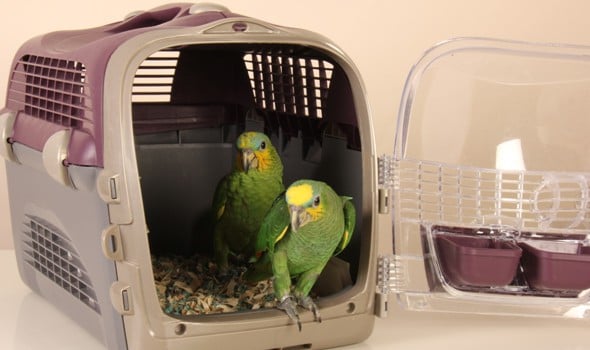
Choosing The Right Bird Travel Carrier
A Bird Travel Carrier – Not Just For Vacations
Will you be prepared if you have to move your bird in a hurry? What if there is an in-home emergency? Or even a simple trip to the vet? These examples of transporting your bird can be stressful for birds who are not use to traveling. It’s important to have your carrier or avian transporter well in advance of any trip. By doing so you can take the time to prepare and teach your bird to get used to the new travel cage rather than waiting until the last minute and trying to wrestle the bird into an unfamiliar object.
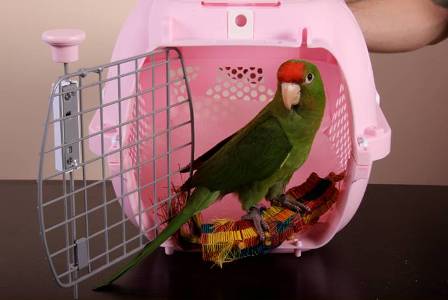
Not All Bird Travel Carrier’s Are Created Equal
Here are some things you should consider when purchasing your bird carrier:
Species
- The size and type of transporter you choose depends heavily on what species of bird you intend to transport. Larger species will need a spacious transporter that allows them to easily stand up and turn around.
- Passerines (finches and canaries) can be safely transported in plastic carriers although the stronger hooked bills such as the cockatoos species can chew through almost any plastic. Acrylic and wire transporters are more suitable.
- Smaller species may pass through gaps in a transporter designed for larger birds. A lot of smaller species get stressed when in a larger transporter as well.
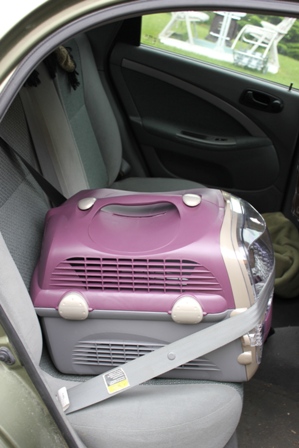
Manageability
- Despite the size and shape of the bird travel carrier you choose, it should be easy to handle and carry around and fit easily in your vehicle.
- The carrier should be made of a sturdy material yet lightweight enough to tote around comfortably.
- A handle on the top is a great feature and allows for easy seat belt access. For larger heavier species a shoulder strap may be desired as well.
Hygiene
- The carrier should be designed to open up easily for cleaning. The less nooks and crannies the better.
- Transporters with a slide out tray are easy to clean without the bird escaping.
- A bottom grill is also handy for keeping your bird separate from soiled substrate or paper linings.
Bird Carrier Substrate
- A paper liner can be used in the bottom of the carrier to reduce slipping while in transport, but it is not quite hygienic when birds feet get soiled with feces.
- If you do choose to use a substrate in the bottom of the carrier for hygiene, a carrier with solid, hole free sides half way up are preferable for reducing mess.
- Phenol free substrates preferably should be used in a carrier that has limited ventilation.
- Paper substrate can be a great option.
Food and Water Bowls
- Food and water bowls should be easy to attach to the bird carrier itself. A lot of travel carriers come with them. They should be easily accessed by the birds and also easily removed for cleaning by the caretaker.
- Water bottles are practical in an avian transporter as they minimize spillage and monitor consumption.
Keep in mind, not all birds are accustomed to drinking from a bottle. Teaching your bird to use the water bottle is important to ensure he will drink an adequate amount of water while travelling. - If you are planning a long trip or the climate is very hot, you might need to add a water bowl if only using a water bottle, to ensure your bird stays hydrated.
Perches for the Carrier
-
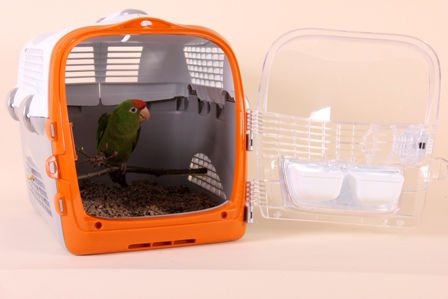
This carrier was fitted with non-toxic natural branch as a perch solution. Some carriers come equipped with a perch, others are designed to allow you to add the specific perch design, material & size adapted for the needs of your particular bird (species, age and size).
- Your bird may feel more secure if it has the possibility to perch inside the carrier especially if he is just getting accustomed to travelling. Some species will not drop feces if they are not able to perch at an adequate height.
- If a perch is desired, place the perch in such a way that when travelling in a vehicle the bird will be positioned sideways and so the perch is positioned in the direction of front to back of the vehicle. Especially with younger birds, there is less chance of losing balance, falling forward and back.A non slippery perch such as a rope perch can provide more comfort and grip. It is also easily bent to meet the size of the carrier.
- The carrier should always be securely seat belted in.
Sleepovers
- Should you want to travel with your bird to a friend over night or for a weekend, you may prefer a carrier that opens up into a play gym and offers the possibility to perch on top of the carrier.
Climate
- Ideally bird travel carriers are designed to provide optimal ventilation for the bird health. A carrier should be designed with exceptionally good ventilation especially when used in hot climates. A carrier with less ventilation might be more suitable for colder climates to reduce exposure to cold and drafts, although carriers with a lot of ventilation area can be covered with warm blankets in colder times.
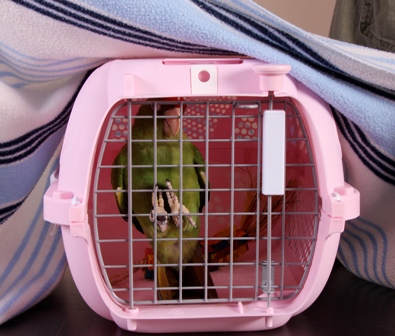
Bird carriers with a lot of ventilation area can be covered with warm blankets when the temperature drops. - Carriers constructed completely of see through plastic panels can cause a lot of stress for birds with less travel experience. Make sure to cover at least half the carrier to provide a sheltered safe zone for these individuals.
- Darker coloured and/or thicker materials used for carrier covers are not recommended in hot weather, but may be necessary in cooler climates.
Airline Approved Bird Carriers
Airlines have specific guidelines as far as animal transportation. Should you at all be travelling by airplane with your bird, you will need to choose a carrier that is airline approved by the specific company your are flying with. Inquire about the specific requirements prior to departure.
Once You’ve Purchased Your Bird Travel Carrier
Identification
- Your Bird’s name, address and the caretakers information should be visible, water and bite proof so that it remains legible.
- Identify your bird’s carrier with as much pertinent information as possible to ensure it can be brought to and cared for by an emergency caretaker in the event that you are not present while it is evacuated.
- A family or friend, your avian veterinarian or boarding facility contact information should be included.
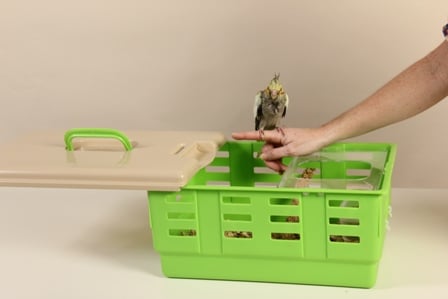
Training sessions are a great time to introduce your bird to a new bird carrier.
Bird Carrier Training Sessions
- Bird Travel Carriers are a lot more confining than your bird’s regular day cage.
- Setting up foraging in the carrier will make it inviting and stress free.
- Positive reinforcement such as play, visual & vocal praise will help make this a positive experience.
- Allowing the bird to enter and leave the carrier as he wishes in the first few desensitization sessions is important, although once accustomed to being comfortable in the carrier, we must insure birds will not take refuge in it, interpreting it as a nesting cavity as this might trigger undesirable hormones and reproductive activity.
Storage
- Keep your carrier in a place easily accessible by everyone in case you need to evacuate in a situation such as fire, hurricane or an emergency trip to your avian veterinarian. If it is placed for storage in a shed or attic it may take too long to get to.
- If stored in an outdoor shed, rodents may invade and soil it. Should this be the case safely clean and disinfect the carrier before using it as rodent feces are dangerous for your bird.


